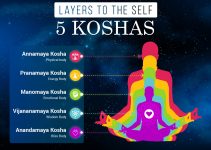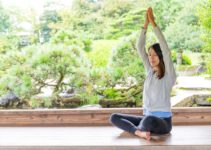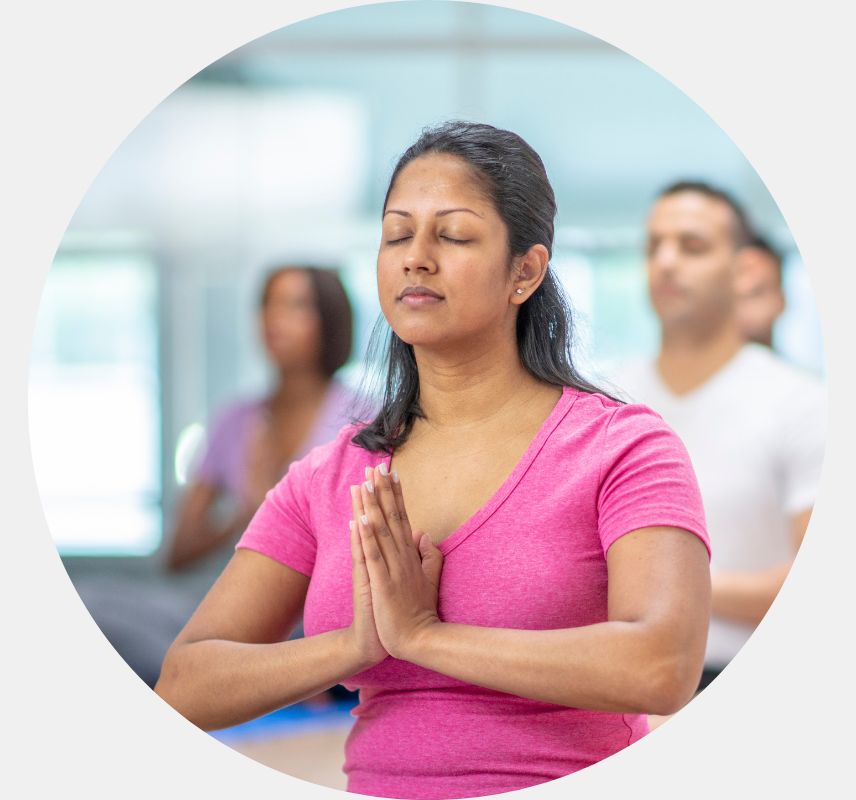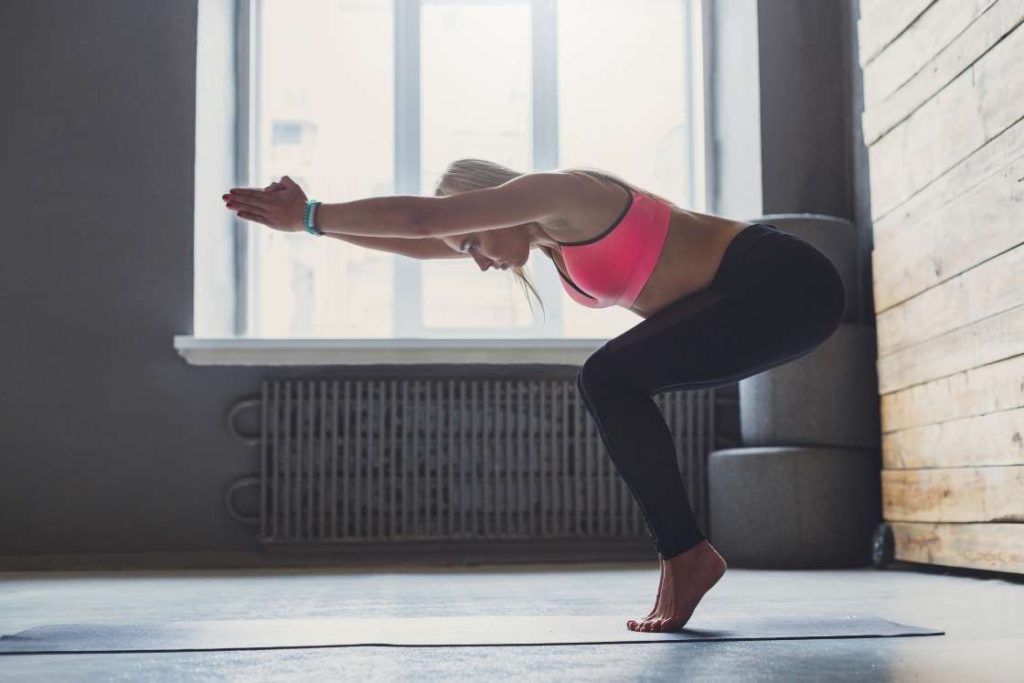
Rocket Yoga is the modified version of Ashtanga Yoga, designed especially for those practitioners who find the latter challenging. Like Ashtanga Yoga, it also comprises Surya Namaskar, seated poses, twists, and bends. However, these could be modified from the traditional poses as per one’s convenience. Thus, every practitioner even those with physical inability to practice Ashtanga Yoga can practice Rocket Yoga.
Rocket Yoga sequence enables the practitioner to interpret their own way of accessing the poses so that no one is left behind while practicing. It is quite popular among the wester practitioners, including celebrities like Madonna, Willem Dafoe, Sting, and Christy Turlington.
It is formed by combining the first, second, and third series of Ashtanga Yoga and practiced following the combined rhythm of breath and movement. Though the practice seems to be involving physical postures, its benefits are still way beyond it.
Along with promoting flexibility, strength, and stability, it makes room for change and freedom in yoga practices. Dive deeper to further understand how it is aimed at having fun while cleansing the mind and body from within.
Origin of Rocket Yoga
The strict hierarchical nature of traditional Ashtanga practice which every practitioner is unable to get hold of gave the inspiration to Larry Schultz to develop rocket yoga aka ‘The Rocket’.
Larry was a disciple of the founder of Ashtanga Yoga, K. Pattabhi Jois, and practiced it following the traditional manner for seven years in Mysore, India. Later Larry moved back to San Francisco in 1989 and started teaching the Ashtanga Yoga there. However, his approach of teaching was different from that of the traditional form, as he wanted all of his students to try and access each pose regardless of their level of practice or expertise.
This contrasting approach from the Ashtanga practice where one can only move forward in the poses after gaining expertise with the approval of the led teacher Larry to develop ‘The Rocket.’ Due to the persuasion of the non-traditional path of teaching yoga, Larry is often addressed as the “Bad Boy of Ashtanga“.
Initially, Schultz referred to his practice as a form of Power Yoga. Later in the mid-1990s when Schultz was traveling as a private yoga instructor of “The Grateful Dead” Band, one of its members, Bob Weir named it “Rocket Yoga. The Rocket is a fast-paced dynamic flow series of poses, hence the name.
Rocket yoga sequence not only shares mutual benefits as Ashtanga yoga but is also categorized in the same manner, as it is further divided into three series which take us to the next section.
The Rocket Sequence
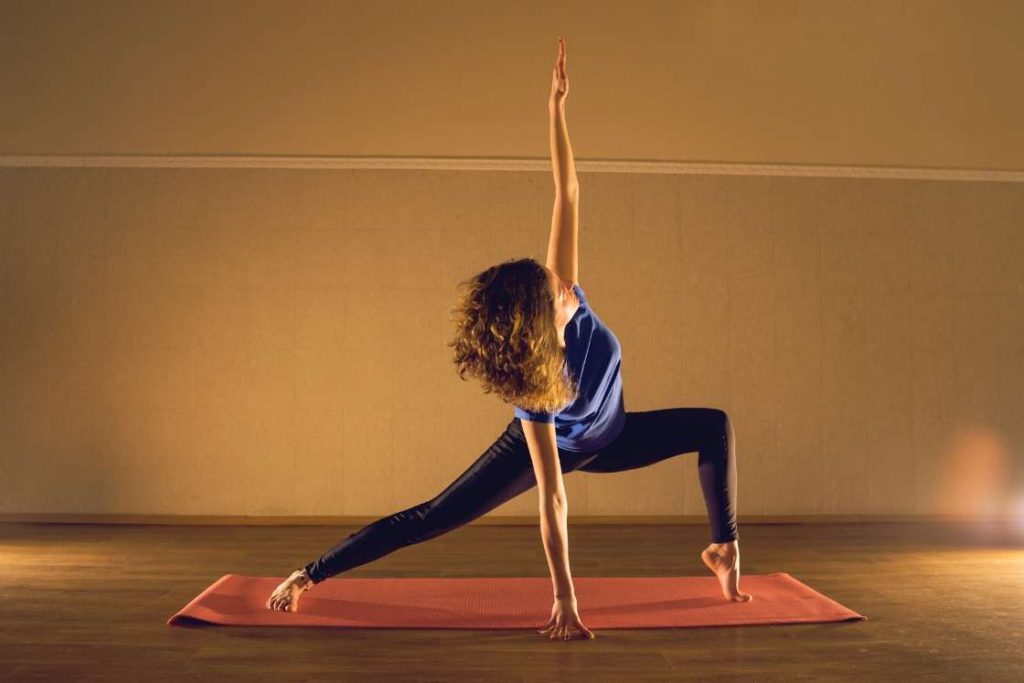
Rocket yoga sequence, aka the rocket sequence, is divided into three series namely, Rocket I, II, and III. These three series contain 142 poses which begin with a warm-up following Sun salutations A and B with a short seated meditation and rest, referred to as “MDR” or “minimum daily requirements”. Then it’s followed by 66 standing, seated, and twisting poses. Finally, the practice ends with the traditional closing series.
1. Rocket I series
The primary rocket yoga series shares similarity with the primary series of Ashtanga Yoga in the following manner:
- It majorly comprises the hip-openers and forward-bending poses.
- They target strengthening the legs and core.
- Special arm balances and inversion are also included in this category.
- Modification of Navasana and Supta Konasana are taught while practicing Rocket I.
2. Rocket II series
It is formed by introducing modification into the second series of Ashtanga Yoga as it involves:
- Techniques of backbends and spinal twists of seated poses of Ashtanga intermediate yoga series.
- Poses like Bakasana and Supta Vajrasana are majorly involved in the second series of the Rocket.
- This series is an energy booster that acts complementary to the first series.
3. Rocket III series
The last series of the Rocket is composed by the fusion of Rocket I and Rocket II and takes the following into consideration:
- It involves poses that target building the strength and flexibility of the practitioner.
- The majority of the poses have the elements of twists, folds, and balances.
- This dynamic and fast-paced series offers a fun transition from Ashtanga’s I through III series, hence often referred to as “The Happy Hour”.
What Makes Rocket Yoga Unique?
Rocket yoga is quite different from Vinyasa, Ashtanga, Bikram, or any other forms of yoga. It is a playful and well-structured form that is easily accessible for each practitioner. Some of the unique features of the Rocket Yoga sequence are put together when compared with other forms of yoga:
- The USP of rocket yoga is considered the fact that it doesn’t follow any hierarchical approach among its poses.
- It is more of a fun or playful yogic activity which is why it lies under less intense practice than that of Ashtanga Yoga.
- Rocket yoga sequences are less rigid and are allowed to be modified by the practitioner.
- Practitioners are even allowed to skip a pose or perform it differently with comfort if they feel stuck on some level.
- The practice is focused on following a repetitive approach as the same yoga sequence will always be taught.
- All the poses that are practiced under the Rocket yoga sequence are held for a longer duration than in the vinyasa yoga practice.
Rocket Yoga Poses
Some of the poses of rocket yoga sequence are described here, read further to get deeper understanding.
1. Crane Pose (Bakasana)
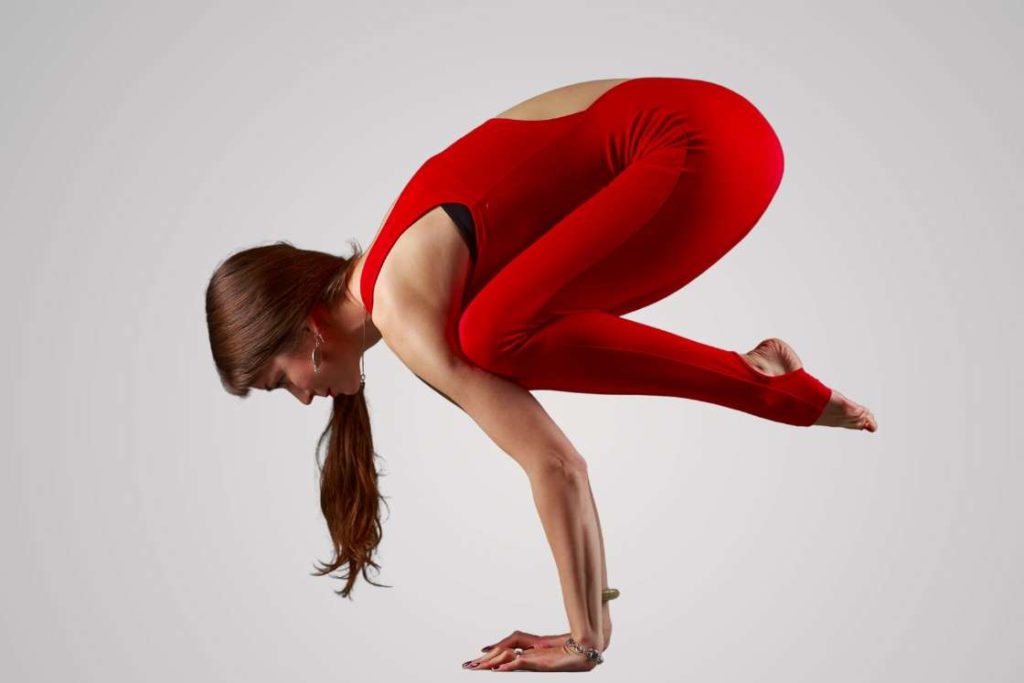
Crane pose is an intermediate pose that is practiced balancing the lifted body on the hands. This posture helps in boosting strength, endurance, and flexibility. To stay stable in this posture it requires concentration and mindfulness, hence crane pose also stimulates the nervous system.
How to do:
- Begin standing tall placing the arms by the sides.
- Bend the knees and fold forward placing the palms flat on the floor under the shoulders.
- Keep the fingers spread wide apart pressing the top joint of the fingers.
- Lifting your heels come up onto the balls of the feet and widen your knees lining up with the upper arms.
- Shift all your weight into the hands lifting your head and come up to your tip toes.
- Lift the foot one by one off the floor keeping the inner thighs engaged and knees pressed against the upper arms.
- Try to take your feet closer to your hips and hold for 5-10 breaths.
- Exhale and transferring the weight back lower your feet to the floor.
2. Peacock Pose (Mayurasana)
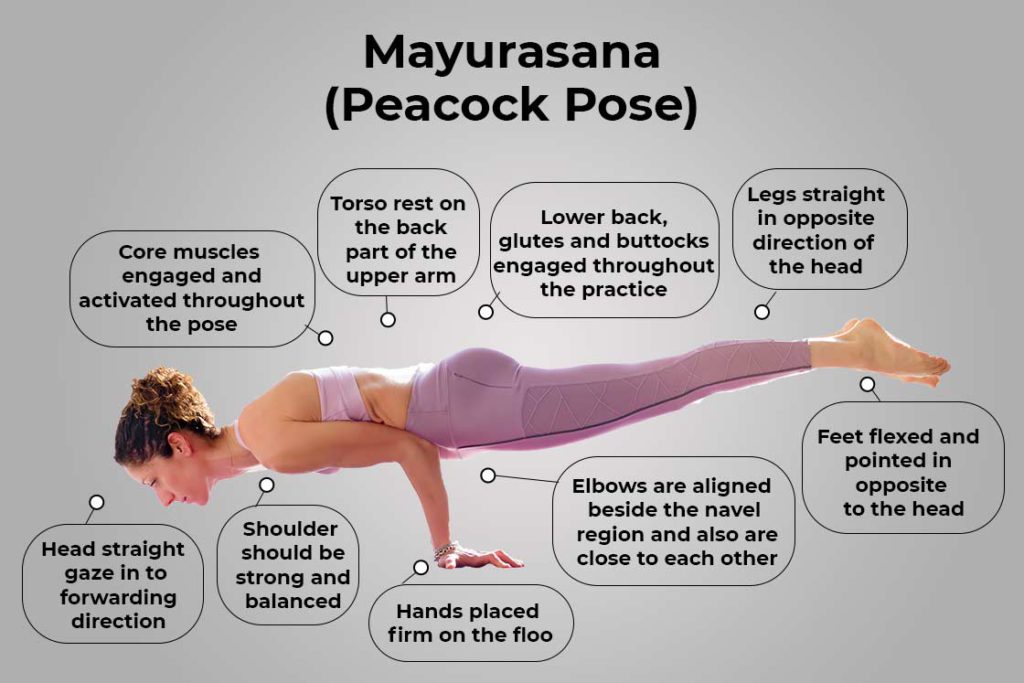
Peacock pose is an advanced hand-balancing posture that engages wrists, forearms, core, and back muscles. The body is lifted off the floor horizontally with only hands on the floor and the legs are raised higher with toes pointing up.
This posture calms the brain, improves focus, and strengthens the core. Besides this, it is therapeutic for diabetes and constipation. Improve your body balance by getting into peacock pose as described below:
How to do:
- Begin sitting in virasana keeping distance between the knees.
- Lean forward and place your hands on the floor with fingers and slightly bend elbows facing towards you.
- Press your palms on the floor simultaneously pressing the torso against the back of the upper arms.
- Straighten your knees and extend your legs behind you with toes pointing to the floor.
- Balance the body on the hands and feet.
- Engaging the core shift your body weight towards the upper body.
- Squeezing your thighs together lift the feet off the floor one at a time.
- Hold this position balancing the entire body on the hands for 10-50 seconds looking forward towards the floor.
3. Eight Angle Pose (Astavakrasana)
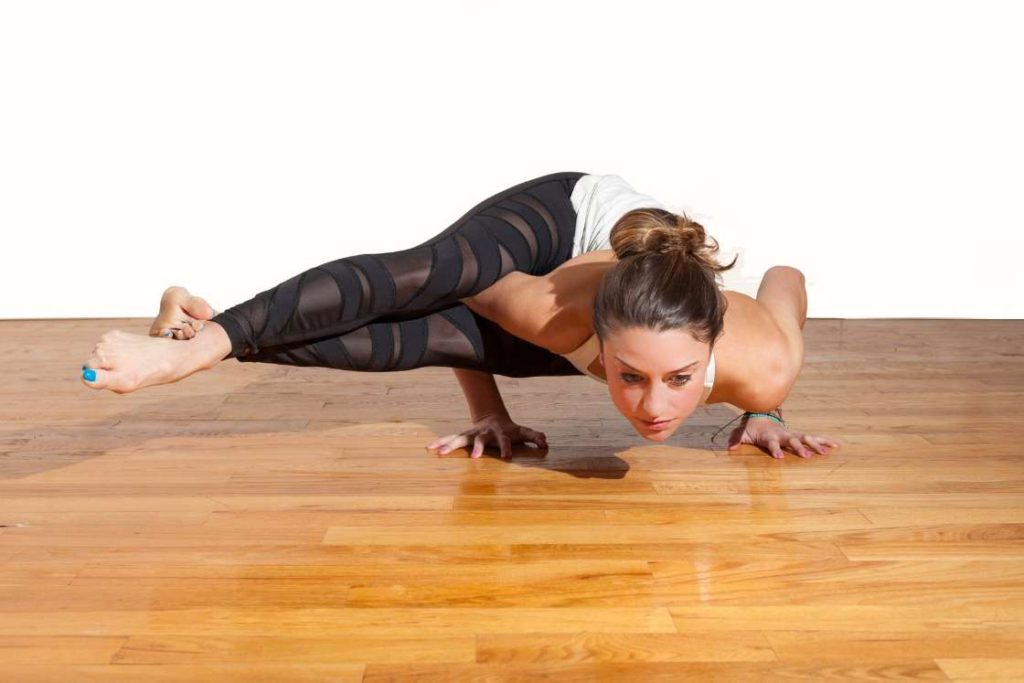
Eight angle pose is also a balancing posture which is quite challenging in nature. It involves forward and side bending, along with elements of twisting and stretching. This posture helps in detoxifying the body, improves balance, strengthens the wrists, arms, and shoulders. Also, it tones the thighs and abdomen. It is also known for developing confidence along with physical strength.
How to do:
- Begin sitting in a cross-legged position.
- Hug your right thigh into your chest and extend the left leg out.
- Thread your right arm under your right knee passing through the inside of your right thigh.
- Keep your right knee as high as possible on the right arm opening the hips.
- Firm both the hands on the floor an pressing the palms lift your body along with left leg off the floor.
- Bend your left knee taking the left foot towards the right and hook both the ankle.
- Extend the legs over to the right side, simultaneously bend your elbows, and shift the weight of the torso forward bringing it parallel to the floor.
- Hold here for a few breaths and then release the legs to come out of the pose.
- Repeat the same on the other side.
4. Headstand (Salamba Sirsasana)
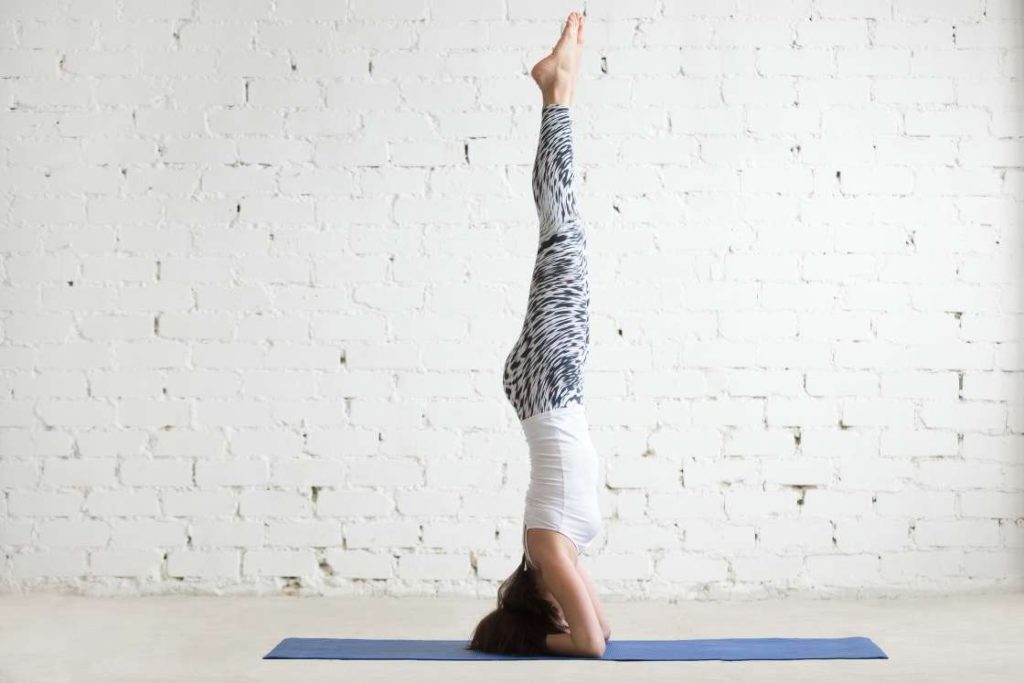
Headstand, as the name conveys it all that it is practiced by the bringing body into an inversion. Balancing the body upside-down keeping only the head on the floor and hands its either sides is quite beneficial. It stimulates the pituitary and pineal glands and also helps in combating mild stress and depression. Patients of asthma, sinusitis and insomnia find it therapeutic.
How to do:
- Sit in Vajrasana and place the opposite hands at the inside base of your upper arms.
- Holding the arms as such place the elbows on the floor.
- Bring your hands together forming a triangle with your forearms on the floor.
- Interlace the fingers together opening the palms and thumbs. Place the tips of the little fingers together.
- Lower your head to the floor cupping the crown of the head inside your hands.
- Lift your hips and straighten your legs keeping the toes curled in.
- Walk your feet towards your head until the hips come above the shoulders.
- Gently lift the feet off the floor one at a time bringing the knees in towards your chest.
- Stay here for 5 seconds and then slowly straighten your legs upwards.
- Hold this position for a few seconds as long as possible.
5. Scorpion Pose (Vrischikasana)
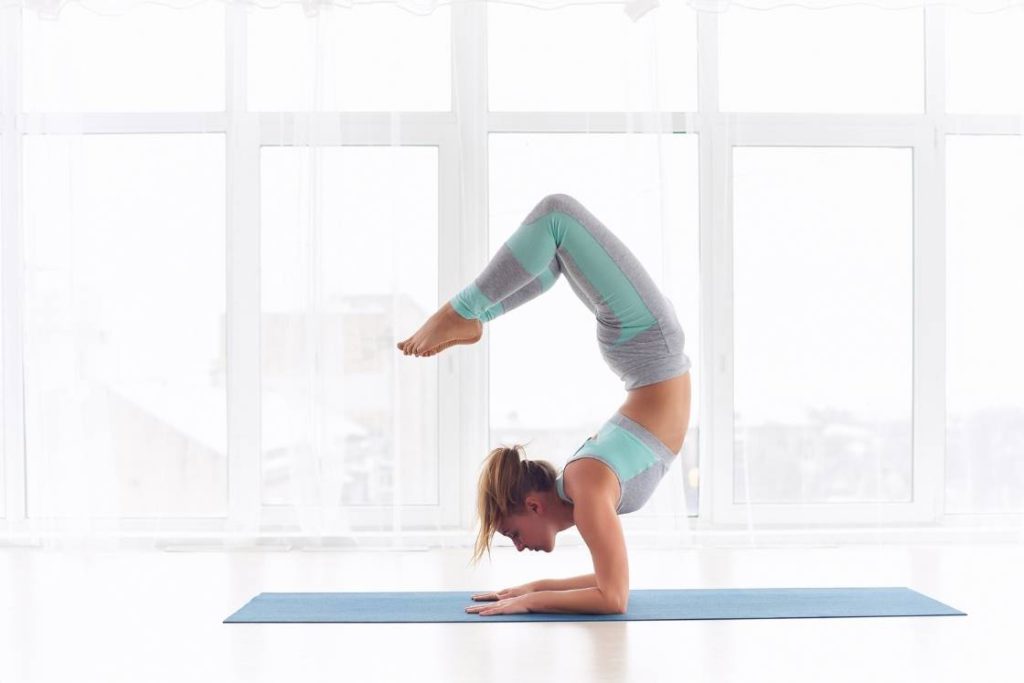
Scorpion pose is a balancing posture that requires core strength and shoulder mobility. It brings the body into an inversion and involves back bending. It is great for improving blood circulation and stimulates pituitary gland. This pose also stretches the hip-flexors and chest muscles along with improving spinal flexibility.
How to do:
- Firstly assume headstand as described above.
- Keep your palms on the floor beside the head on each side and keep the neck relaxed.
- Bend your knees to lower your feet towards the hips.
- Open your chest up and lift the head off the floor keeping the gaze on the floor.
- Hold the pose for a few seconds keeping the back slightly curved.
- Release by the coming back to the headstand and then lowering the feet to the floor. Relax in child’s pose.
Precautions to be considered in Rocket Yoga
Rocket yoga follows the same approach as that of Power Yoga when it comes to speed. Due to the face pace dynamic flow, various risks are involved with rocket yoga Sequence. Hence, taking precautions is the sane thing to do before and while practicing Rocket Yoga.
- Before stepping into rocket yoga, it is recommended to work on gaining upper body strength and overall fitness to match the pace of this practice.
- You must accumulate some basic understanding of yoga considering the breathwork, bandhas, and Drishti.
- Getting familiar with breathwork can prevent muscle strains and ligament tear. Even balance and stability are enhanced by syncing the breath with the movement, thus helps in practicing safely and avoids falls.
- Risk of injuries can also be avoided by developing a better understanding of the ashtanga yoga form, poses, and the duration of each pose.
- Ensure a healthy lifestyle and fitness regime and opt suitable exercise routine as per your health.
- Taking the appropriate number of resting days for your exercise routine is recommended.
- Pregnant women check with their doctors as well as take instructor’s proper guidance before practicing rocket yoga sequence.
Tips for Rocket Yoga Beginners
Here are some of the tips that every newbie must apply for safely practice Rocket Yoga eliminating all the injuries or risks associated with it. These tips would also come in handy to enjoy and harness all the benefits of Rocket Yoga.
- Do not compare your practice with other practitioners.
- Follow your own pace acknowledging the limits and potentials of your body.
- Be patient while practicing and get perfection over time, not overnight.
- Accept the modifications and improvisations from the instructor for your practice. It will help in boosting your stability and focus.
- Remember the breath is the key to harness the energy and master the flow within the poses.
- It is often recommended to gather previous experience in Hatha and Vinyasa Yoga before getting into Rocket Yoga.
Benefits of Rocket Yoga
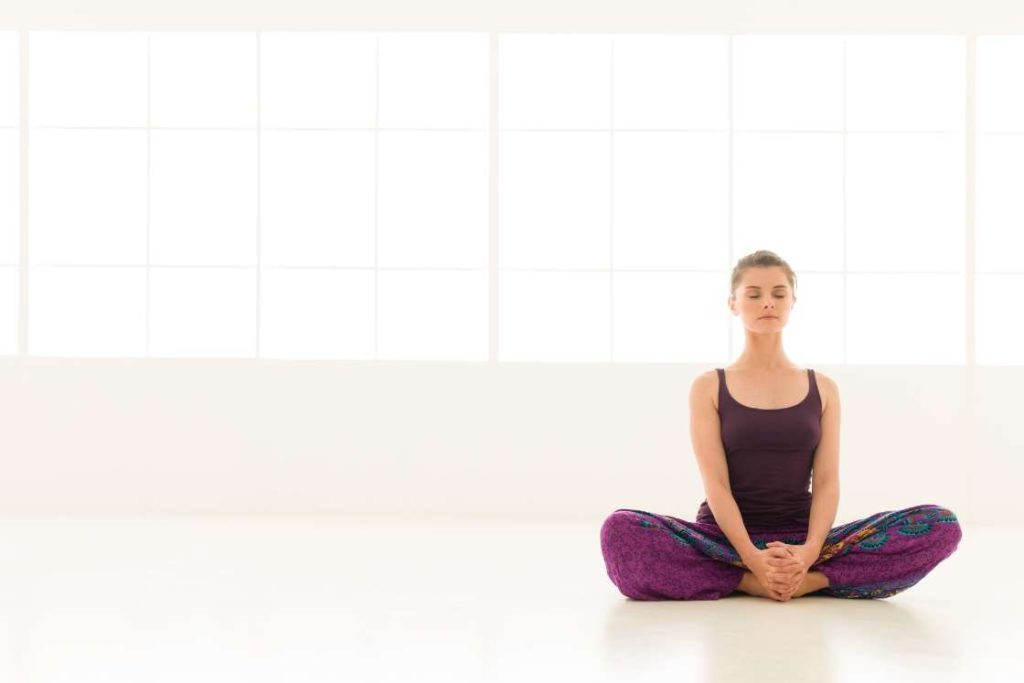
Several health benefits are gained practicing Rocket Yoga that makes this incredibly fast moving practice worth trying and accepting with the fact that anyone can go for it.
1. Helps to lose weight
Since you already know rocket yoga is an incredibly high-paced practice, thus it serves as an intense cardio-workout. This aids in toning the muscles, brings body in shape, and burns calories. Hence, practicing rocket yoga is all what you want to get back into a shape and get rid of all the stubborn body fat.
2. Enhances strength and flexibility
Since most of its poses involve balance, stability, and stretches. Also, it engages the entire body with a smooth flow of breath and develops endurance. The stretching of the joints and muscles enhances flexibility and makes you stronger.
3. Promotes mental health
Poses of rocket yoga sequence involving inversions, backbends, and balancing body off the floor brings in mindfulness. They also promote the flow of oxygen and blood to the brain which beneficial for calms the brain. Thus, the rocket also promotes mental health and keeps issues like, anxiety, depression, and stress at the bay.
4. Improves balance and stability
Another benefit of rocket yoga is that it works towards improving motor skills. The poses performed under rocket yoga sequence are held for a longer duration and face-paced that not only makes the muscles stronger but also helps in enhancing mind-body coordination. It is also therapeutic in curing Parkinson’s disease.
5. Boosts cardiovascular health
Due to the fast pace of rocket yoga, the heart and circulatory system is also exercised. It increases the heart rate and allows better circulation and improves cardiovascular strength. With improving cardiovascular health, major risk associated with the heart and circulatory system like high blood pressure, heart stroke, etc. can be eliminated. Also, it keeps the cholesterol in control, prevents diabetes, and also strengthens the lungs.
Conclusion
If at any point of time in your life you have felt stuck in your exercising routine but just can’t let go of it, switching to rocket yoga sequence is something that you must go for. It helps you get all your fitness goals that too without leaving your comfort zone.
Rocket yoga can be seen as a fun and pleasure taking workout that works great for not only your physical health but also takes psychological health into consideration. Just follow all the safety measures given above and get moving into this beneficial yoga style.
